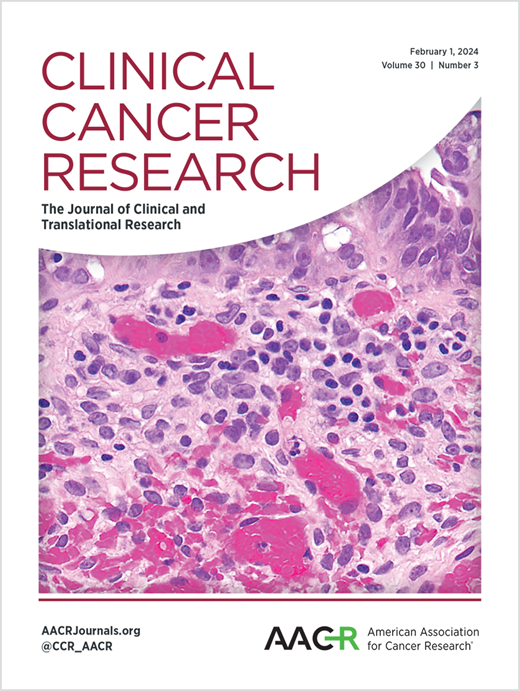NeoPembrOV/GINECO II期随机试验揭示高级别浆液性卵巢癌的肿瘤微环境和PD-L1表达
IF 10.2
1区 医学
Q1 ONCOLOGY
引用次数: 0
摘要
目的:描述PD-L1在组织类型及其相关肿瘤微环境(TME)中的表达,并研究其如何影响NeoPembrOV II期试验(NCT03275506)中treatment-naïve卵巢癌(OC)患者对派姆单抗反应的预测值。方法:采用肿瘤比例评分(TPS)和免疫细胞评分(IC)对85例患者(转移56例,输卵管卵巢29例)的PD-L1表达进行评估,≥1%为阳性,≥5%为高表达。进行RNA测序和多重免疫荧光检测。澳大利亚卵巢癌研究(AOCS)被用作外部验证队列。结果:PD-L1主要在输卵管卵巢肿瘤细胞(TCs)和转移瘤细胞(ic)中表达。与对照组相比,在派姆单抗组中,评估转移的ic评分与更长的PFS相关。与输卵管卵巢相比,转移灶在T细胞和B细胞以及GZMBCD8细胞毒性T细胞特征中富集。在转移瘤中,ic评分与免疫浸润和额外免疫检查点如IDO1、LAG3、ICOS的过表达有关,而TPS与细胞增殖、免疫浸润和干扰素- γ途径有关。在输卵管卵巢中,TPS与细胞增殖和抗原呈递通路相关,但在激活的免疫通路中缺失,CD274的表达与缺氧和PI3K/Akt/mTOR信号通路相关。讨论:不同组织类型的PD-L1表达模式与OC中不同的生物学途径和TME相关,影响PD-L1的预测值。我们的研究结果为卵巢癌患者定制免疫治疗提供了新的HGSC生物学见解。本文章由计算机程序翻译,如有差异,请以英文原文为准。
Unravelling the tumor microenvironment and PD-L1 expression across tissue type in high-grade serous ovarian cancer in the NeoPembrOV/GINECO phase II randomized trial
Purpose: To describe PD-L1 expression across tissue types and its associated tumor microenvironment (TME) and to investigate how it impacts its predictive value for response to pembrolizumab in treatment-naïve ovarian cancer (OC) patients included in the NeoPembrOV phase II trial (NCT03275506). Methods: PD-L1 expression was assessed for 85 patients (56 on metastasis, 29 on tubo-ovary) using tumor proportion score (TPS) and immune cell (IC) score, considering positivity if ≥ 1% and high expression if ≥ 5%. RNA sequencing and multiplex immunofluorescence were conducted. The Australian Ovarian Cancer Study (AOCS) was used as an external validation cohort. Results: PD-L1 was primarily expressed by tumor cells (TCs) in tubo-ovaries and by ICs in metastases. IC-score assessed on the metastases was associated with a longer PFS in the pembrolizumab arm compared to the control arm. Compared to tubo-ovaries, metastases were enriched in T and B cells as well as in GZMBCD8 cytotoxic T cell signatures. In metastases, IC-score was associated with immune infiltration and overexpression of additional immune checkpoints such as IDO1, LAG3, ICOS while TPS was associated with cell proliferation, immune infiltration and interferon-gamma pathways. In tubo-ovaries, TPS was associated with pathways linked to cell proliferation and antigen presentation but depleted in activated immune pathways, and CD274 expression was correlated with hypoxia and PI3K/Akt/mTOR signaling. Discussion: Distinct PD-L1 expression patterns across tissue type are associated with different biological pathways and TME in OC impacting PD-L1 predictive value. Our results provide novel insights in HGSC biology for tailoring immunotherapy in OC patients.
求助全文
通过发布文献求助,成功后即可免费获取论文全文。
去求助
来源期刊

Clinical Cancer Research
医学-肿瘤学
CiteScore
20.10
自引率
1.70%
发文量
1207
审稿时长
2.1 months
期刊介绍:
Clinical Cancer Research is a journal focusing on groundbreaking research in cancer, specifically in the areas where the laboratory and the clinic intersect. Our primary interest lies in clinical trials that investigate novel treatments, accompanied by research on pharmacology, molecular alterations, and biomarkers that can predict response or resistance to these treatments. Furthermore, we prioritize laboratory and animal studies that explore new drugs and targeted agents with the potential to advance to clinical trials. We also encourage research on targetable mechanisms of cancer development, progression, and metastasis.
 求助内容:
求助内容: 应助结果提醒方式:
应助结果提醒方式:


